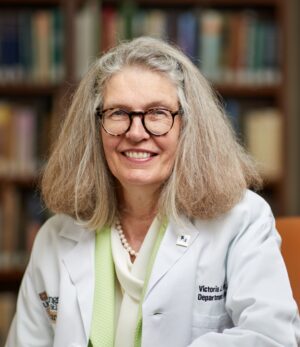
The Division of Infectious Diseases was established at Washington University School of Medicine in 1942, when W. Barry Wood Jr., MD, became head of the Department of Internal Medicine. Wood’s lifelong research lay in the interaction between pathogenic bacteria and phagocytic cells, including mechanisms of the febrile response.
Carl G. Harford, MD, was the first head of the division and supervised the clinical, diagnostic, bacterial, and virology laboratories at Barnes Hospital. The addition of Robert J. Glaser, MD, and M. Kenton King, MD, established the division as one of the premier training programs in the country.
Gerald Medoff, MD, became head of the division in 1972, when Harford retired. Medoff’s research interest was medical mycology, which he pursued in collaboration with George S. Kobayashi, PhD, director of the clinical mycology laboratory at Barnes Hospital. The division was designated as a National Institutes of Health (NIH) Mycology Center with the only NIH training grant in mycology in the country.
An NIH training grant shared with the Department of Molecular Microbiology and the Division of Pediatric Infectious Diseases was also awarded in 1972 and continues today.

Medoff and Kobayashi were joined by J. Russell Little, MD, who became the head of Infectious Diseases at The Jewish Hospital of St. Louis. During Medoff’s tenure, the division increased in size and added a number of different programs over the next 27 years, including a highly successful AIDS Clinical Trials Unit (ACTU) headed by William G. Powderly, MD, a superb program in hospital epidemiology headed by Victoria J. Fraser, MD, an international program focused on filariasis headed by Gary J. Weil, MD, and basic research collaborations with investigators in the Department of Microbiology.
In 1989, Medoff divided the division into two sections, each led by co-directors. Under this strategy, experienced clinicians provided patient care, did clinical research, and advanced the educational mission of the division, while basic investigators focused primarily on conducting laboratory-based research and serving as mentors to trainees. This novel restructuring of the division allowed the development and expansion of both clinical and basic science research on equal terms. Eric J. Brown, MD, was made head of the basic science section, while Medoff continued to serve as head of the clinical section.
Medoff stepped down in 1992 to become vice chairman of Medicine and was succeeded by William G. Powderly, MD as co-director and head of the clinical section. During his nine years of service, Powderly significantly increased the inpatient and outpatient clinical services and research enterprise of the division and directed the ACTU. Powderly’s research focused on optimizing treatment and prevention of opportunistic infections and understanding the metabolic complications of AIDS. In 1999, Daniel E. Goldberg, MD, PhD, a distinguished investigator in the molecular pathogenesis of malaria, was appointed to lead the basic sciences section. He continued as co-director of the division until January 2019. Dr. Goldberg has served in many important roles at Washington University School of Medicine including heading the university’s Medical Scientist Training Program (MSTP) for many years, and serving in multiple leadership roles in the Division of Biology and Biomedical Sciences. Following his longstanding service to research administration and graduate training, Goldberg returned his focus to his laboratory and transitioned the division’s basic science leadership to another outstanding physician-scientist, Jennifer A. Philips, MD, PhD. Philips is recognized for her scientific accomplishments, her collaborative leadership style, and commitment to mentoring the next generation of infectious disease physicians and scientists.

Fraser became head of the clinical section in 2005 after Powderly returned to Ireland to become Dean of Medicine at University College Dublin. Under her leadership, the division continued to expand clinical infectious diseases service delivery and research, becoming the largest provider of HIV care in the region.
The division also developed contracts to manage what have become highly regarded programs including:
- Infection prevention
- Antibiotic management
- Employee health
- Quality improvement
- Medical informatics
In 2012, Fraser was appointed Chair of the Department of Medicine. Powderly returned from Ireland in 2013 to become the co-director of the division and the director of the Institute of Public Health at Washington University.
Washington University in St. Louis occupies the ancestral, traditional, and contemporary lands of the Osage Nation, Otoe-Missouria, Illinois Confederacy, Quapaw, Ho-Chunk, Miami and many other tribes as the custodians of the land where we reside, occupy, and call home
We recognize their sovereignty was never ceded after unjust removal and encourage your own research on tribal removal, tribal sovereignty and the history of the land you reside.
We promote the inclusion of tribal history and the incorporation of contemporary thoughts and actions into your work.
In offering this land acknowledgement, we affirm and support Tribal sovereignty, history and experiences by elders past, present, and seven generations yet to come through their continued connection to this land.